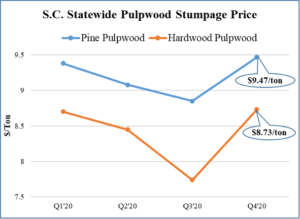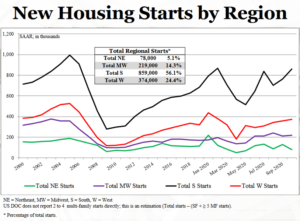South Carolina stumpage market trends:
In Q4/2020, prices for both sawtimber and pulpwood (pine and hardwood trees) have recovered from the slump seen in the last quarter, Q3/2020. In a year-over-year comparison, sawtimber prices are still lower, but pulpwood prices have almost recovered to the same levels seen in Q4/2019 last year.

South Carolina Q4/2020 sawtimber stumpage price:
Hardwood sawtimber had a steep drop in prices in the first three quarters of 2020, but it has recovered to overtake pine sawtimber prices this quarter. It is an increase of about 14% from the prices seen in the last quarter. On average, South Carolina pine sawtimber prices statewide were $22.03/ton in the 4th quarter of 2020. For mixed hardwood sawtimber, statewide prices, on average, were $22.84/ton in this quarter.

South Carolina Q4/2020 pulpwood stumpage price:
Both pine and hardwood pulpwood prices have recovered from the last quarter drop. On average, South Carolina statewide pine pulpwood prices were $9.47/ton in the 4th quarter of 2020. For mixed hardwood pulpwood, the statewide stumpage prices, on average, were $8.73/ton in this quarter. As compared to their prices in the last quarter, pine and hardwood pulpwood prices have increased by about 7% and 12%, respectively, in this quarter.
Overall economy and housing market conditions and local environments such as accessibility/terrain, competition, sale size, tree size and quality, and distance to the nearby mills affect stumpage prices for both sawtimber and pulpwood. Historically, stumpage prices in the southern US tend to decline in hot and dry summer months when harvesting activities could continue with little constraints, unlike in wet weather conditions when some tracts could be inaccessible. Properly managed trees in good health and condition would likely get paid more than unmanaged trees.

Housing updates:
Housing has shown a strong recovery after hitting a low point in the spring. It remains a bright spot for the US economy during this pandemic-induced economic shock. Single-family starts have been positive for seven straight months, induced by strong demand and low mortgage rates. This trend will likely depend on the overall labor market and mortgage conditions. It might see some decline if the labor market weakens and lenders start to tighten mortgage credits.
Data credit: The sawtimber and pulpwood price data included in this newsletter are published with permission from TimberMart-South Athens, GA 30605 email tmart@timbermart-south.com. Housing data credit to the housing report by Virginia Tech, Virginia Cooperative Extension, and the U.S. Forest Service.
This article was originally featured in the Winter 2021 Version of CU in The Woods newsletter.
Author(s)
Puskar Khanal, Cooperative Extension, Forestry and Wildlife Specialist
This information is supplied with the understanding that no discrimination is intended and no endorsement of brand names or registered trademarks by the Clemson University Cooperative Extension Service is implied, nor is any discrimination intended by the exclusion of products or manufacturers not named. All recommendations are for South Carolina conditions and may not apply to other areas.
Clemson University Cooperative Extension Service offers its programs to people of all ages, regardless of race, color, gender, religion, national origin, disability, political beliefs, sexual orientation, gender identity, marital or family status and is an equal opportunity employer.
